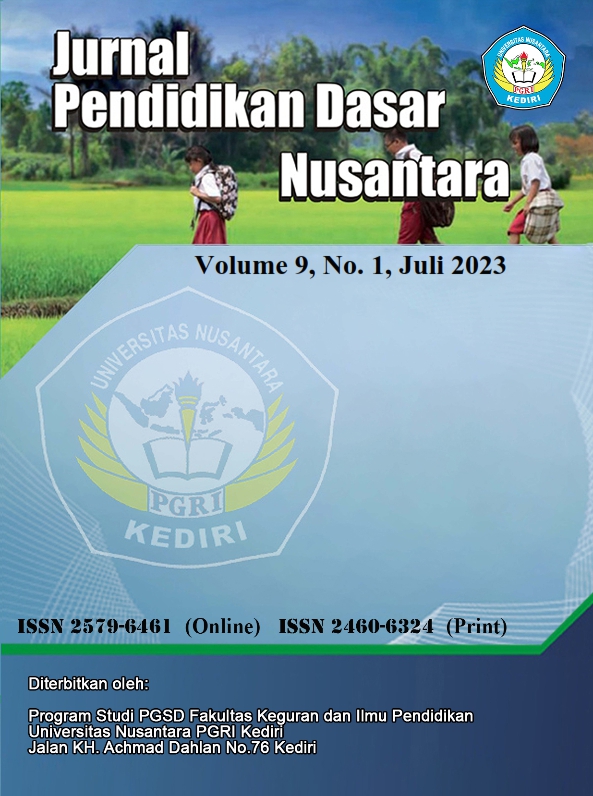The effectiveness of scrapbook media on students' learning outcomes in thematic learning for 3rd grade at SDN Deket Kulon Lamongan
DOI:
https://doi.org/10.29407/jpdn.v9i1.19099Keywords:
Scrapbook Media, Learning Outcomes, Thematic LearningAbstract
Thematic learning is a teaching approach that combines or integrates various concepts from multiple subjects or fields of study into a single theme or specific topic. This research is motivated by the fact that there are issues with the implementation of Thematic Learning at SDN Deket Kulon Lamongan, including the insufficient use of thematic learning media by teachers, resulting in students' learning outcomes not fulfil the minimum completeness. Based on these problems, there is a need to employ learning media to aid students in understanding Thematic Learning concepts, thus enhancing their learning outcomes. The objective of this study is to employ the Scrapbook media and determine its effectiveness in Thematic Learning on the learning outcomes of 3rd Grade students at SDN Deket Kulon Lamongan. The research method used is quantitative research with an experimental design, specifically the one-group pre-test post-test design. The results of the research indicated that in the paired samples t-Test, the obtained significance value (sig) is 0.000 < 0.05, demonstrating the influence of Scrapbook media on students' learning outcomes in Thematic Learning for 3rd Grade at SDN Deket Kulon Lamongan. Furthermore, the average post-test scores of students showed an improvement of 16.9. Hence, it can be concluded that the Scrapbook media has a significant impact on enhancing students' learning outcomes in Thematic Learning for 3rd Grade at SDN Deket Kulon Lamongan.
Downloads
References
Bambang Soepono. (1997). Statistik Terapan Dalam Penelitian Ilmu-Ilmu Sosial Dan Pendidikan. Jakarta: Rineka Cipta
Carolus Borromeus Mulyatno. 2022. “Jurnal Pendidikan Dan Konseling.” Jurnal Pendidikan dan Konseling 4: 1349–58.
Cecep Kustandi dan Daddy Darmawan. (2020). Pengembangan Media Pembelajaran Jakarta: Divisi Prenada Media Group
Hardani dkk. (2020). Metode Penelitian Kualitatif & Kuantitatif. Yogyakarta: CV. Pustaka Ilmu.
Hari Purnomo dan Eka Siswanto Syamsul. (2012) Statistka Farmasi (Aplikasi Praktik dengan SPSS). Yogyakarta: CV. Grrafika Indah
Ibadullah Malawi dan Ani Kadarwati. (2017). Pembelajaran Tematik (Konsep Dan Aplikasi). Magetan: CV. Ae Media Grafika
Maita Damayanti. 2017. Pengaruh Media Scrapbook (Buku Tempel) Terhadap Hasil Belajar Siswa Materi Keanekaragaman Rumah Adat Di Indonesia Kelas IV Sekolah Dasar. Jurnal Penelitian Pendidikan Guru Sekolah Dasar Vol 5 No 3 (2017).
Muhammad Ramli. 2012. Media Teknlogi Pembelajaran. IAIN Antasari Press
Munasik. 2015. Kemampuan Guru Sekolah Dasar Dalam Menerapkan Pembelajaran Tematik Di Sekolah. Jurnal Pendidikan 15, no. 2
Nana Sudjana dan Ibrahim. 1998. Penelitian Pendidikan. Bandung: PT. Sinar Baru
Pratiwi. Pengembangan Media Scrapbook Subtema Komponen Ekosistem Untuk Kelas V Sekolah Dasar. (Skripsi Universitas Malang, 2017)”.
Purwatiningsih, Hani, Sri Lestari, and Melik Budiarti. 2020. “Efektivitas Penggunaan Media Scrapbook Terhadap Hasil Belajar Tematik Siswa SD.” Prosiding Konferensi Ilmiah Dasar 2: 313–20. http://prosiding.unipma.ac.id/index.php/KID.
Ramen Purba and Imam Rofiki. Pengantar Media Pembelajaran (Jakarta: Yayasan Kita Menulis, 2020).
Ridwan Wibiantoro. Perancangan Media Inovasi Berbasis Kearifan Budaya Lokal Di SD (Kediri: CV Srikandi Kreatif Nusantara, 2021).
Sari, Indah Puspita, Nani Yuliantini, and Pebrian Tarmizi. 2020. “Pengaruh Penggunaan Media Scrapbook Terhadap Hasil Belajar Pada Pembelajaran Tematik Siswa Kelas IV SD Gugus X Kota Bengkulu.” Jurnal Riset Pendidikan Dasar 3(3): 1–8. https://ejournal.unib.ac.id/index.php/juridikdasunib/article/view/14563.
Sugiyono. 2015. Metode Penelitian Kuanttatif Kualitatif, dan R&D.
Downloads
Published
Issue
Section
License
Authors who publish with this journal agree to the following terms:
- Copyright on any article is retained by the author(s).
- The author grants the journal, the right of first publication with the work simultaneously licensed under a Creative Commons Attribution License that allows others to share the work with an acknowledgment of the work’s authorship and initial publication in this journal.
- Authors are able to enter into separate, additional contractual arrangements for the non-exclusive distribution of the journal’s published version of the work (e.g., post it to an institutional repository or publish it in a book), with an acknowledgment of its initial publication in this journal.
- Authors are permitted and encouraged to post their work online (e.g., in institutional repositories or on their website) prior to and during the submission process, as it can lead to productive exchanges, as well as earlier and greater citation of published work.
- The article and any associated published material is distributed under the Creative Commons Attribution-ShareAlike 4.0 International License

































